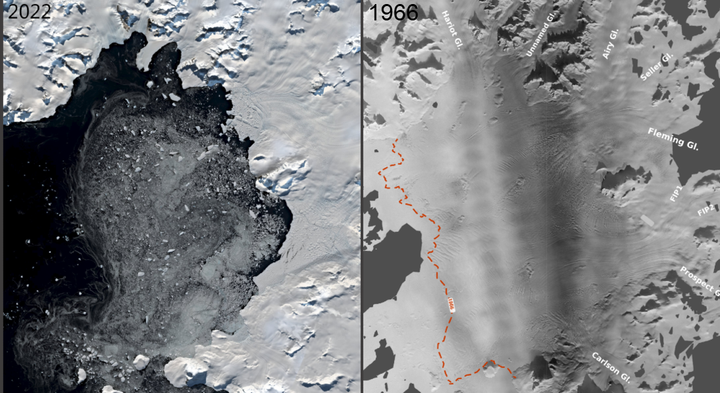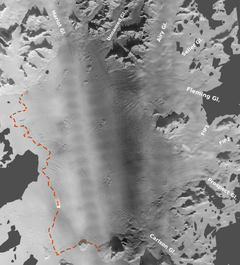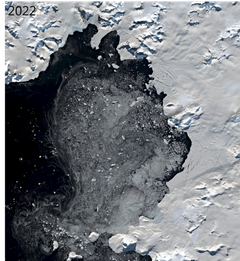Old aerial photos give scientists a new tool to predict sea level rise
Researchers from the University of Copenhagen have gained unique insight into the mechanisms behind the collapse of Antarctic ice shelves, which are crucial for sea level rise in the Northern Hemisphere. The discovery of old aerial photos has provided an unparalleled dataset that can improve predictions of sea level rise and how we should prioritise coastal protection and other forms of climate adaptation.

On 28 November 1966, an American aeroplane flies over the Antarctic Peninsula just south of the southernmost tip of Chile.
On board is a photographer, probably from the US Navy, whose job is to map the Antarctic landscape. But it turns out that the photographer is also documenting a very special situation that is in progress. He shoots an aerial photo of the Wordie Ice Shelf, which, 30 years later, has almost vanished after a total collapse.
The consequence of this collapse was that the ‘plug’ that held large amounts of glacier ice broke off, leaving the ice sheet floating freely into the sea.
Fortunately, Wordie is a relatively small ice shelf and the sea level rise it has caused can be measured in millimetres. But there are much larger ice shelves in Antarctica, which, like Wordie, could collapse due to climate change. Just the two largest ice shelves, Ronne and Ross, are believed to hold enough ice to account for sea level rises of up to five metres.
If, in this context, we think that Antarctica is far away, we need to understand that the melting of ice in the Southern Hemisphere will cause sea levels to rise in places like Denmark in the Northern Hemisphere, due to the effects of gravity. A new research study provides insights that can help identify signs of incipient collapse in these ice shelves and assess the stage of collapse.
The photo of Wordie from 28 November 1966 - the first in a long series of images that continually document the collapse of the Wordie Ice Shelf through the 1960s - has become a valuable first data point in a study of the ice shelf collapse recently completed by researchers at the University of Copenhagen.
In their paper, now published in Nature Communications, they present a unique dataset based on the vast archives of old aerial images combined with modern satellite observations, which, for the first time, shows the collapse of an ice shelf as a constant evolution in a long time series. A critical insight that can be used to improve scientists' understanding of ice shelves and the mechanisms behind their collapse.
"We have identified several signs of incipient ice shelf collapse that we expect will be observed in other ice shelves, but perhaps more importantly, the dataset has given us a multitude of pinning points that can reveal how far advanced a collapse is. It's a completely new tool that we can use to do reality checks on ice shelves that are at risk of collapsing or already in the process of collapsing," says Postdoc Mads Dømgaard from the Department of Geosciences and Natural Resource Management, who is lead author of the study.
According to the researchers, this knowledge will enhance computer models of sea level rise and lead to more accurate predictions of when the water will rise, allowing for prioritisation of investments in climate change adaptation in the most effective way.
Warmer seawater and melting under the ice were most conclusive
The hundreds of historical aerial photos were analysed using a technique known as structure-from-motion photogrammetry. The method has enabled scientists to accurately reconstruct ice thickness, as well as its extent, surface structure and flow velocity, dating back to the 1960s.
In this way, the researchers analysed the collapse of Wordie and learned more about the factors involved. It was previously assumed that a warmer atmosphere was the primary factor leading to the collapse, and, similarly, that the formation of meltwater lakes on the ice surface had also played a part. The new study has disproved both assumptions.
Instead, the researchers highlight melting under the ice where the sea and ice meet as definitive factors.
"Our findings show that the primary driver of Wordie's collapse is rising sea temperatures, which have generated the melting beneath the floating ice shelf," Mads Dømgaard says.
Collapse is tougher than we thought – like it or not
Furthermore, the study's findings have already altered the foundation of scientists' knowledge about ice shelf collapse. According to co-author Anders Anker Bjørk, the new data advances our understanding of how and at what speed these collapses occur.
"The tentative conclusion from our findings is that ice shelf collapse may be slower than we thought. This means that the risk of a very rapid development of violent sea level rise from melting in Antarctica is slightly lower, based on knowledge from studies like this one," says Anders Anker Bjørk, Assistant Professor at the Department of Geosciences and Natural Resource Management.
But there is also a flip side to this, he explains:
"It was already a supertanker that needed to be turned to stall the melting of ice in Antarctica, but our data shows a collapse process that is even more protracted than previously assumed. And this longer process will make it harder to reverse the trend once it has started. This is an unambiguous signal to prioritise halting greenhouse gas emissions now rather than sometime in the future," Anders Anker Bjørk says.
*
Facts: ice shelves and sea level rise
Ice shelves, like Wordie, act as a kind of brake on glaciers flowing from the ice sheet towards the sea. When an ice shelf vanishes, the glaciers lose this support and can begin to float and melt more rapidly.
As the ice mass of ice shelves is already partially or wholly in the sea, their direct contribution to sea level rise is limited. On the other hand, the glacier ice they retain is on land and, therefore, every cubic metre affects the water level of the world's oceans.
Although Antarctica is far away, areas like Denmark are being affected significantly by sea level rise caused by ice shelf collapses resulting from gravitational forces. Before Antarctica melts, its ice mass helps pull sea waters southwards. When the ice has melted into the sea, the gravitational field has changed, causing the oceans to the north to rise proportionally more.
Facts: How dusty old photos became important data
In the study, the researchers used images from multiple overflights of Wordie, shot between 1966 and 1969.
In analysing the historical aerial photos, the researchers employed the structure-from-motion photogrammetry method, which utilises overlapping photos to calculate accurate three-dimensional models of landscapes or objects.
By analysing differences in perspective between the photos, it’s possible to measure heights and distances with high accuracy. This allows tracing how the ice surface, thickness and velocity have changed over time.
Behind the Research:
The following researchers contributed to the scientific article:
Department of Geoscience and Natural Resource Management, University of Copenhagen, Denmark:
Mads Dømgaard
Jonas K. Andersen
Anders A. Bjørk
Université Grenoble Alpes, France:
Romain Millan
Eric Rignot (Also affiliated with: University of California and California Institute of Technology, USA)
University of California, Irvine, Department of Earth System Science, USA:
Bernd Scheuchl
Delft University of Technology, Department of Geoscience and Remote Sensing, The Netherlands:
Maaike Izeboud
Université de Toulouse, France:
Maud Bernat
Keywords
Contacts
Mads DømgaardPostdocDepartment of Geoscience and Natural Resource Management, University of Copenhagen
Tel:+45 35 32 50 38mld@ign.ku.dkAnders Anker BjørkAssistant ProfessorDepartment of Geoscience and Natural Resource Management, University of Copenhagen
Tel:+45 35 33 16 55Tel:+45 29 92 17 42aab@ign.ku.dkKristian Bjørn-HansenPress and Communications OfficerUCPH Communication, University of Copenhagen
Contact the Press Team:
Images
Links
Subscribe to releases from Københavns Universitet - Det Natur- og Biovidenskabelige Fakultet
Subscribe to all the latest releases from Københavns Universitet - Det Natur- og Biovidenskabelige Fakultet by registering your e-mail address below. You can unsubscribe at any time.
Latest releases from Københavns Universitet - Det Natur- og Biovidenskabelige Fakultet
Intergalactic experiment: Researchers hunt for mysterious dark matter particle with clever new trick15.8.2025 11:01:00 CEST | Press release
Physicists from the University of Copenhagen have begun using the gigantic magnetic fields of galaxy clusters to observe distant black holes in their search for an elusive particle that has stumped scientists for decades.
Intergalaktisk eksperiment: Forskere jagter mystisk mørkt stof-partikel med snedigt trick15.8.2025 11:01:00 CEST | Pressemeddelelse
Fysikere fra Københavns Universitet bruger gigantiske magnetfelter i galaksehobe til at observere sorte huller i jagten på en partikel, der har mystificeret forskere i årtier.
Nyt studie peger på Skagerrak som et slags ”fritidshjem” for den gådefulde grønlandshaj9.7.2025 09:00:00 CEST | Pressemeddelelse
Grønlandshajen – verdens længstlevende hvirveldyr – forbindes oftest med kolde arktiske vande. Et nyt internationalt studie ledt af forskere fra Grønlands Naturinstitut og Københavns Universitet viser dog, at Skagerrak sandsynligvis fungerer som opvækstområde for unge grønlandshajer. Studiet peger også på at grønlandshajer slet ikke fødes i hverken Grønland eller andre steder i Arktis.
Gamle luftfotos giver forskere nyt redskab til at forudsige havstigninger3.7.2025 08:00:00 CEST | Pressemeddelelse
Forskere fra Københavns Universitet har fået unik adgang til at forstå mekanismerne bag antarktiske ishylders kollaps, som er afgørende for havstigninger på den nordlige halvkugle. Et fund af gamle luftfotos har skabt et enestående datasæt, som kan forbedre vores forudsigelser af hvor meget havene stiger, og vores prioritering af kystsikring og andre klimatilpasninger.
Ny institutleder på IFRO: ”Faglighed og fællesskab går hånd i hånd”1.7.2025 10:49:17 CEST | Pressemeddelelse
Per Svejstrup er fra 1. august ansat som institutleder på Institut for Fødevare- og Ressourceøkonomi (IFRO). Den kommende leder træder ind i rollen med stor respekt for IFRO's faglige og kollegiale kultur med klare ambitioner for fremtiden.
In our pressroom you can read all our latest releases, find our press contacts, images, documents and other relevant information about us.
Visit our pressroom

